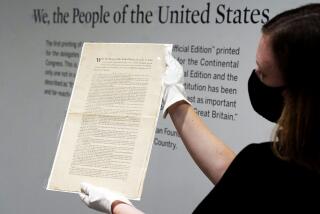Rare 16th-century Mesoamerican codex goes online at the Library of Congress
- Share via
The Library of Congress has made the extraordinarily rare Codex Quetzalecatzin available online. Also known as the Aztec Codex, it was created sometime between 1570 and 1595 and shows native Aztec and Nahuatl maps, hieroglyphs and illustrations side-by-side with some text written in Spanish.
It is one of fewer than 100 surviving illustrated Mesoamerican manuscripts dating before 1600.
Also known as the Mapa de Ecatepec-Huitziltepec, the manuscript contains information about a family with the name of “de Leon,” including its genealogy and land holdings.
The lands depicted in the codex stretch between modern-day Mexico City and Atoyatempan, a town in southeastern Mexico.
At the Library of Congress blog, curator John Hessler wrote, “On the one hand, the map is a traditional Aztec cartographic history with its composition and design showing Nahuatl hieroglyphics, and typical illustrations. On the other hand, it also shows churches, some Spanish place names, and other images suggesting a community adapting to Spanish rule.
“The codex shows graphically the kinds of cultural interactions taking place at an important moment in American history. In a sense, we see the birth of what would be the start of what we would come to know as the Americas.”
The codex’s provenance can be traced to the 19th century, according to the Library of Congress. Its previous owners include newspaper publisher William Randolph Hearst and British politician Weetman Pearson, 1st Viscount Cowdray. The Library of Congress acquired it from a French collector earlier this year.
ALSO
Books to give and get this season
The beautiful Airstream myth and painful RV reality of life on the road
More to Read
Sign up for our Book Club newsletter
Get the latest news, events and more from the Los Angeles Times Book Club, and help us get L.A. reading and talking.
You may occasionally receive promotional content from the Los Angeles Times.








